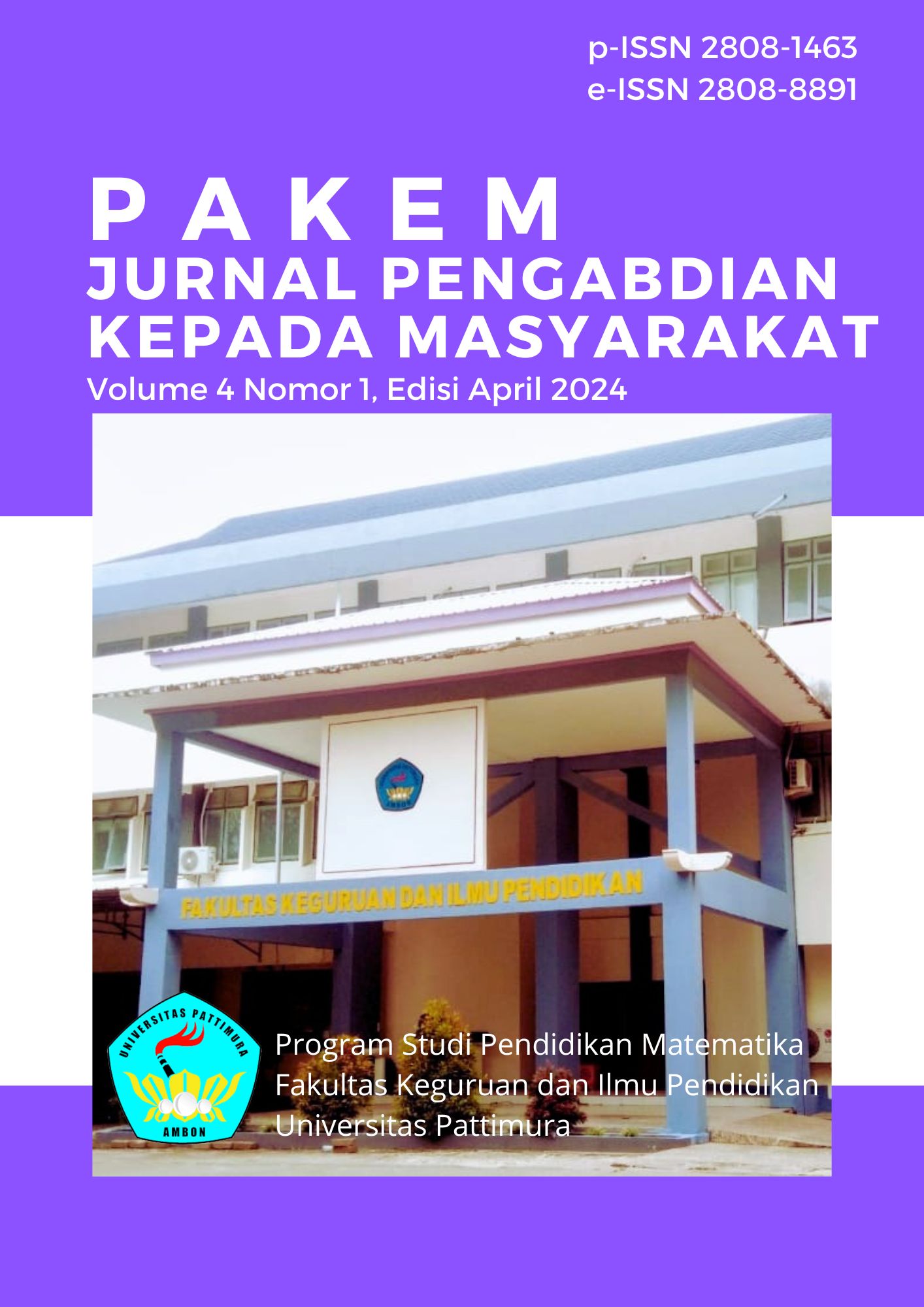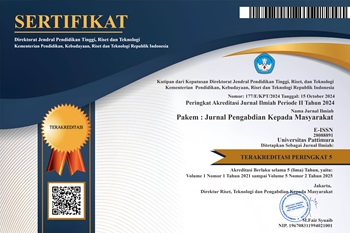LAYANAN PEMERIKSAAN LABORATORIUM MEDIS DASAR SEBAGAI UPAYA DETEKSI DINI SINDROM METABOLIK WARGA TIAL BARU DESA SULI KECAMATAN SALAHUTU
Abstract
Sindrom metabolik merupakan faktor predisposisi terjadinya diabetes melitus dan penyakit jantung yang ditandai dengan obesitas sentral, hipertensi, hiperglikemia, serta dislipidemia. Kegiatan ini bertujuan untuk memberikan layanan pemeriksaan laboratorium medis dasar untuk deteksi sindrom metabolik bagi warga Tial Baru Desa Suli Kecamatan Salahutu. Sesuai kriteria National Cholesterol Education Program- Adult Treatment Panel III Cholesterol disimpulkan bahwa sebanyak 59% warga mengalami sindrom metabolik berdasarkan pada hasil pengukuran lingkar perut, tekanan darah serta kadar glukosa darah puasa. Disarankan kepada masyarakat untuk memperbaiki pola hidup dengan cara mengontrol asupan gizi, mengatur pola aktivitas fisik serta manajeman stres.
Downloads
References
Atmaja, R. F. D., Orno, T. G., Yuniarty, T., & Sari, J. I. (2023). Basic Medical Laboratory Services as an Effort to Detect Metabolic Syndrome in Anduonohu Sub-District, Kendari City. Jurnal Berkala Kesehatan, 9(1), 40. https://doi.org/10.20527/jbk.v9i1.14530
Ben-Assayag, H., Brzezinski, R. Y., Berliner, S., Zeltser, D., Shapira, I., Rogowski, O., Toker, S., Eldor, R., & Shenhar-Tsarfaty, S. (2023). Transitioning from having no metabolic abnormality nor obesity to metabolic impairment in a cohort of apparently healthy adults. Cardiovascular Diabetology, 22(1), 1–14. https://doi.org/10.1186/s12933-023-01954-w
Brouwer-Brolsma, E. M., Sluik, D., Singh-Povel, C. M., & Feskens, E. J. M. (2018). Dairy shows different associations with abdominal and BMI-defined overweight: Cross-sectional analyses exploring a variety of dairy products. Nutrition, Metabolism, and Cardiovascular Diseases : NMCD, 28(5), 451–460. https://doi.org/10.1016/j.numecd.2018.01.008
Chen, W., Balland, E., & Cowley, M. A. (2017). Hypothalamic Insulin Resistance in Obesity: Effects on Glucose Homeostasis. Neuroendocrinology, 104(4), 364–381. https://doi.org/10.1159/000455865
Denorme, F., Portier, I., Kosaka, Y., & Campbell, R. A. (2021). Hyperglycemia exacerbates ischemic stroke outcome independent of platelet glucose uptake. Journal of Thrombosis and Haemostasis : JTH, 19(2), 536–546. https://doi.org/10.1111/jth.15154
Dhawan, D., & Sharma, S. (2020). Abdominal Obesity, Adipokines and Non-communicable Diseases. The Journal of Steroid Biochemistry and Molecular Biology, 203, 105737. https://doi.org/10.1016/j.jsbmb.2020.105737
Driyah, S., Oemiati, R., Rustika, R., & Nova, S. H. (2019). Prediktor Sindrom Metabolik : Studi Kohor Prospektif Selama. Media Litbangkes, 3(September), 215–224.
Orno, T. G., Madiuw, D., & Siauta, V. A. (2022). Edukasi dan Deteksi Dini Sindrom Metabolik pada Masyarakat Desa Waai Kecamatan Salahutu. Karya Kesehatan Siwalima, 1, 1–6. https://doi.org/10.54639/kks.v1i1.720
Haris, S., & Tambunan, T. (2016). Hipertensi pada Sindrom Metabolik. Sari Pediatri, 11(4), 257. https://doi.org/10.14238/sp11.4.2009.257-63
Lee, S., & Kuk, J. L. (2017). Visceral fat is associated with the racial differences in liver fat between black and white adolescent boys with obesity. Pediatric Diabetes, 18(7), 660–663. https://doi.org/10.1111/pedi.12492
Misra, A., & Bhardwaj, S. (2014). Obesity and the metabolic syndrome in developing countries: focus on South Asians. Nestle Nutrition Institute Workshop Series, 78, 133–140. https://doi.org/10.1159/000354952
Riskesdas. (2013). Riset Kesehatan Dasar (RISKESDAS) 2013. Laporan Nasional 2013, 1. http://www.dof.gov.my/en/c/document_library/get_file?uuid=e25cce1e-4767-4acd-afdf-67cb926cf3c5&groupId=558715
Rus, M., Crisan, S., Andronie-Cioara, F. L., Indries, M., Marian, P., Pobirci, O. L., & Ardelean, A. I. (2023). Prevalence and Risk Factors of Metabolic Syndrome: A Prospective Study on Cardiovascular Health. Medicina (Kaunas, Lithuania), 59(10). https://doi.org/10.3390/medicina59101711
Sigit, F. S., Tahapary, D. L., Trompet, S., Sartono, E., Willems van Dijk, K., Rosendaal, F. R., & de Mutsert, R. (2020). The prevalence of metabolic syndrome and its association with body fat distribution in middle-aged individuals from Indonesia and the Netherlands: a cross-sectional analysis of two population-based studies. Diabetology & Metabolic Syndrome, 12, 2. https://doi.org/10.1186/s13098-019-0503-1
Sihombing, M., & Tjandrarini, D. H. (2015). Faktor Risiko Sindrom Metabolik pada Orang Dewasa di Kota Bogor. Nutrition and Food Research, 38(1), 21–30. https://doi.org/10.22435/pgm.v38i1.4418.21-30
Soelistijo, S. (2021). Pedoman Pengelolaan dan Pencegahan Diabetes Melitus Tipe 2 Dewasa di Indonesia 2021. Global Initiative for Asthma, 46. www.ginasthma.org.
Subramani, S. K., Mahajan, S., Chauhan, P., Yadav, D., Mishra, M., Pakkirisamy, U., & Prasad, G. B. K. S. (2019). Prevalence of metabolic syndrome in Gwalior region of Central India: A comparative study using NCEP ATP III, IDF and Harmonized criteria. Diabetes & Metabolic Syndrome, 13(1), 816–821. https://doi.org/10.1016/j.dsx.2018.12.003
Tim Riskesda. (2018). Laporan Riskesdas 2018 Nasional.pdf. In Lembaga Penerbit Balitbangkes (p. hal 156). https://repository.badankebijakan.kemkes.go.id/id/eprint/3514/1/Laporan Riskesdas 2018 Nasional.pdf
World Health Organization. (2021). Hypertension. World Health Organization. https://www.who.int/news-room/fact-sheets/detail/hypertension
Copyright (c) 2024 PAKEM : Jurnal Pengabdian Kepada Masyarakat

This work is licensed under a Creative Commons Attribution-NonCommercial-ShareAlike 4.0 International License.
Authors who publish with PAKEM: Jurnal Pengabdian Kepada Masyarakat agree to the following terms:
- Authors grant copyright to the journal and right of first publication with the work simultaneously licensed under a Creative Commons Attribution License (CC BY-NC-SA 4.0)
- Authors are able to enter into separate, additional contractual arrangements for the non-exclusive distribution of the journal's published version of the work (e.g., post it to an institutional repository or publish it in a book), with an acknowledgment of its initial publication in this journal.
- Authors are permitted and encouraged to post their work online (e.g., in institutional repositories or on their website) prior to and during the submission process, as it can lead to productive exchanges, as well as earlier and greater citation of published work.


.jpg)













